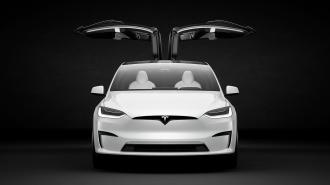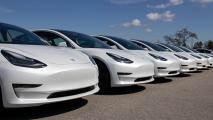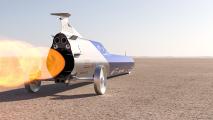Tesla has announced plans to eliminate the use of rare earth elements in its powertrains — but the move alone won’t be enough to significantly combat the problems caused by the metals.
Rare earth elements: Seventeen of the 118 elements on the periodic table are classified as “rare earths,” and although these metals aren’t rare in a conventional sense, they are widely dispersed in Earth’s crust, which makes mining them a challenge.
Today, 63% of the world’s rare earths mining happens in China, using processes that release toxic chemicals into the environment. The metals are then used in many products, including permanent magnets, which can be found in most electric vehicle (EV) motors.
“We have designed our next drive unit, which uses a permanent magnet motor, to not use any rare earth materials at all.”
Colin Campbell
Why it matters: While we need to transition to EVs to combat climate change, the mining of rare earth elements for EV motors will still harm the environment in a different way. It’s important to avoid as much of this collateral damage as possible.
The use of rare earths also means the transition to EVs is dependent upon the US maintaining a cordial relationship with China. If Beijing decided to withhold the elements as a political power move — as it has in the past with Japan — EV production in the US could grind to a halt.
What’s new? On March 1, Tesla announced at its 2023 Investor Day event that it has reduced the amount of rare earths in its Model 3’s powertrain by 25% since 2017. It also revealed that it plans to completely eliminate their use in future powertrains.
“We have designed our next drive unit, which uses a permanent magnet motor, to not use any rare earth materials at all,” said Colin Campbell, Tesla’s VP of powertrain engineering.
The alternative: Tesla’s announcement was light on details — the company didn’t say which elements it currently uses in its motors, when it plans to start producing cars with the new drive train, or what it plans to use to create permanent magnets instead of rare earth materials.
However, several research groups have designed permanent magnets without rare earths, so it’s possible Tesla will incorporate one of those options into the drive train, or maybe it’ll develop something completely new.
The trend: The idea of an EV motor without rare earth elements isn’t unheard of — Tesla didn’t start using permanent magnet motors until 2017 — but alternatives typically use electric currents to create magnetism, which takes extra energy from a vehicle’s battery pack and reduces its range.
Now, Tesla is one of many EV makers trying to transition away from rare earth elements without jeopardizing performance — BMW and Nissan have eliminated their use entirely in certain vehicles, while Toyota and Volkswagen have reduced the amount of rare earths in their motors.
The big picture: Tesla is the biggest EV brand in the US, so its transition away from rare earth elements will have a larger impact than other automakers’. Still, its motors represent just 2-3% of the global demand for permanent magnets, according to a report by market research company Adamas Intelligence.
To truly address the current problems with rare earths, we’re going to need to look beyond Tesla and EVs and toward eliminating the use of the metals in as many products as possible while also pursuing environmentally friendlier ways to mine them in places other than China.
We’d love to hear from you! If you have a comment about this article or if you have a tip for a future Freethink story, please email us at tips@freethink.com.






